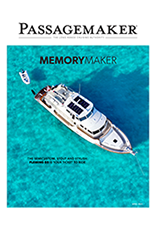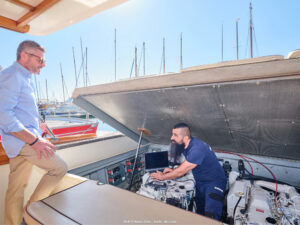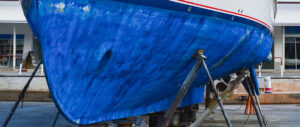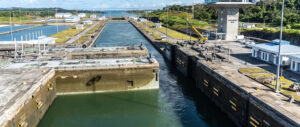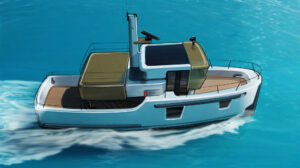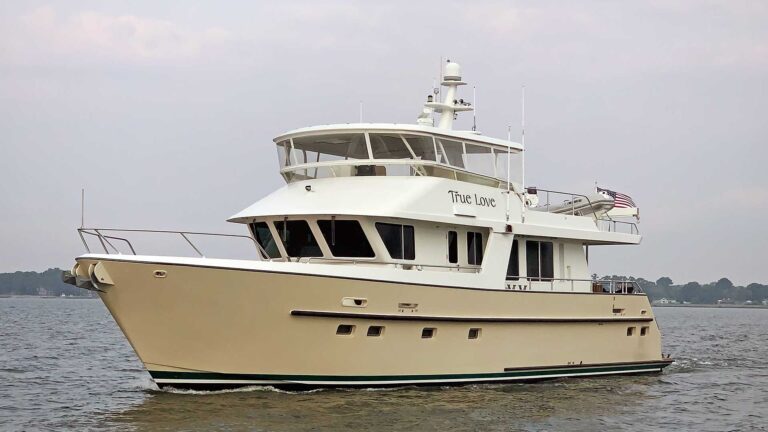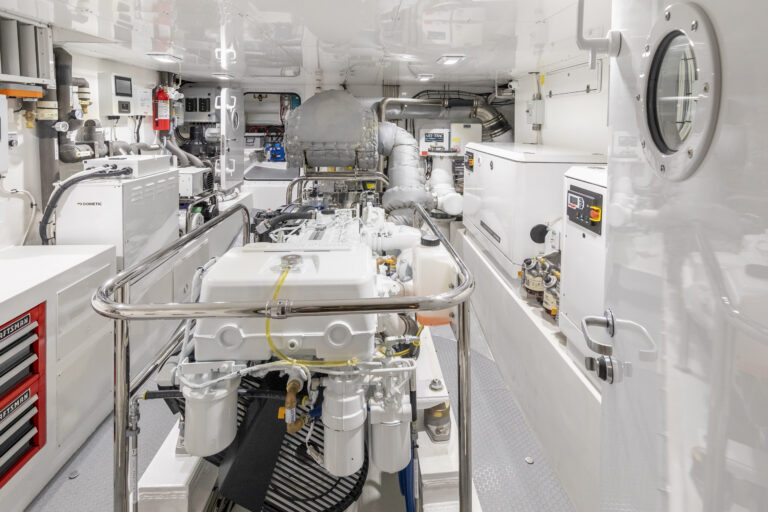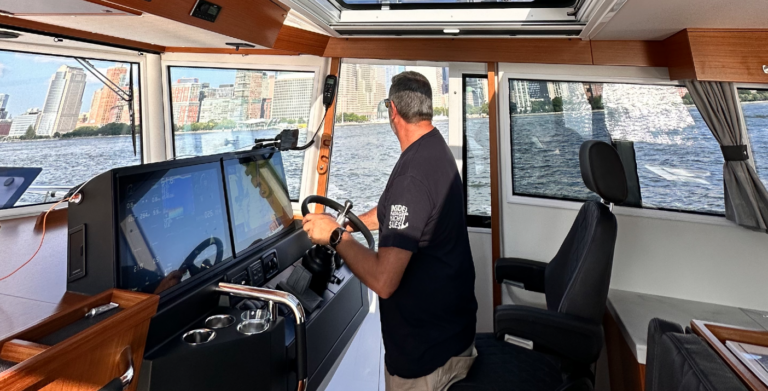
Back in the 1970s and 80s, boating magazines would occasionally feature some rich-kid dropout whose dream was to carry freight between Caribbean islands under sail. There was a “gee-whiz” tone to the writing, clueless to the fact that such trade had never really stopped. To this day, Haitian cargo sloops continue to make the run to Nassau in the Bahamas. By any measure these rustic watercraft are one of the most successful small-boat designs in history.
Haitian sailing masters had been running cargo and contraband up through the Bahamian islands since the 1600s. Those of you that have cruised those emerald waters surely remember seeing these engineless, lateen-rigged vessels, reaching up and down in the lee of the Exuma archipelago.

With apologies to the studs among you that have taken boats south, my opinion is that the Haitians are the finest sailors in these islands, and their boats are a living window to the 17th century. The original “buccaneers” set out from Haitian ports and used the superior maneuverability of this ancient French design—particularly in light air—to swarm the ponderous Spanish galleons.
Even if you haven’t been down island, you have probably seen the Haitian sloop in TV news footage showing the U.S. Coast Guard taking the passengers of a horribly overloaded boat into custody. News accounts often refer to the boats as ramshackle, which is usually not true. They are sturdy workboats that happen to be used for smuggling. You can justifiably abhor the greed that risks the lives of a couple hundred people on a 52-foot craft, but that’s not the boatbuilder’s fault.

In general, they are very heavily built, with the hull planks more than an inch thick and frames varying, some six-by-six-inch, others one-by-six. As I recall, the fastenings were clinched nails. The spars, as you can see from the photos, are not straight, having been hewn from palm trees. Standing rigging is heavy steel cable and running rigging appeared to be ¾-inch nylon. Ballast is moveable: stones or coral. Like the old wooden “Novies” of Nova Scotia, these Haitian workboats have a lifespan dictated by the materials used. They earn their keep, wear out and are then replaced.

In 2007, the British Marine Accident Investigation Branch studied the circumstances in which a Haitian sloop had capsized near the Turks and Caicos, a British protectorate, while under tow by the island marine police. More than 60 migrants died in the tragedy. Interestingly, the investigators concluded that despite the weight of more than 125 people, the 37-foot boat was “relatively stable” until passengers surged on deck once the boat had been intercepted.
According to the Forced Migration Project of Oxford University, between 55,000 and 100,000 Haitian boat people managed to reach Florida in the 20 years leading up to 1981.
I have heard estimates that Haitian sloops conveyed as many as a quarter million migrants to South Florida over the decades, poor people crossing nearly 700 miles of water to become the region’s kitchen workers and cab drivers, fruit pickers and drywall hangers.
They had fled a country where the average lifespan is 53 years and unemployment is said to be 60 percent. One of the few economic bright spots are the dollars sent back from Haitian migrants working stateside. Since 1982, when the U.S. Coast Guard ramped up its interdiction of migrant boats, more than 100,000 Haitians have been intercepted at sea, most of them to be repatriated. Thousands more have died trying to reach “lot bo dlo,” Creole for “the other side of the water,” in overloaded vessels that capsized or broke up.
Illegal immigration is an issue in the Bahamas, too. And for the past decade Bahamian authorities have been rounding up and repatriating Haitians by the thousands, even though Haitians do the work that Bahamians don’t want to do, a phrase that may sound familiar.

Today, Haitian sloops are more unwelcome than ever; their traditional legal trade of charcoal and produce is largely obsolete—Bahamians cook with gas now and get their vegetables from the U.S.—but the smuggling of people and drugs continues. The Bahamas crackdown has a curious racial element. Bahamians, most of whom would be considered “black” by U.S. standards, tend to disparage Haitian migrants as inferior in part because their skin color is generally even darker.
About ten years ago anchored at Staniel Cay, I spied a Bahamian patrol boat towing a Haitian sloop on her hip to the government dock. I grabbed the camera, jumped in the dinghy and headed for the pier.
With only the captain remaining aboard, Bahamian authorities were towing the 45-footer to be searched for contraband. The vessel’s three-man crew were being interrogated separately at the OPBAT base on Great Exuma. OPBAT is the anti-trafficking initiative by the U.S. Coast Guard and elite members of the Bahamian police.
Their search had come up empty, and the police were saying that this was one of the “cleanest” Haitian boats they had ever boarded. Still, searchers all wore rubber gloves and face masks while down below. I sidled over to where I could get a word with the sloop’s skipper, who sat through the entire process with the ingrained patience of the powerless.

“Are you going to cut this guy loose,” I asked? The Bahamian inspector said yes, eventually, and the sloop’s crew would be airlifted from Great Exuma. I took this as a signal that I could interview their captive.
Coughing, he said his name was Albert Pierre, and he was 41. His English was good from having spent so many years plying Bahamian waters. His cough came from extended exposure to one of his frequent northbound cargoes—charcoal. Haiti’s poverty is a vicious circle in which charcoal plays a leading role. The hillsides are deforested to render charcoal, soil erodes, and in the absence of fertile soil for crops, desperate people cut whatever trees remain for more charcoal. On deck, the sloop also carried sacks of ginger roots, whose health benefits Capitan Pierre happily explained to his captors. The ship’s skiff was filed with a dozen or so tinker-made charcoal stoves. No cocaine.
For 300 years Haitian boats have navigated the same trade route, passing by and sometimes clearing Customs at Great Inagua on the Bahamas southern frontier, then navigating the shallow banks west of the Exuma chain. Few cruisers brave the southernmost reaches of this old trade route, fearing the shallow sands, despite the aid of sonar and satellite technology.
I asked Capitan Pierre if he had GPS. “No, GPS would be better, but too expensive,” he said, reaching into a deck locker. He showed me a wet compass in a rough box. “How about charts? Do you carry charts?” I asked. “No just this,” he said, holding his compass.

Pierre said his return cargos to Haiti often are loads of clothing discarded by Bahamians. On other Haitian boats back then, the home-bound cargoes were items scavenged from Nassau’s dump—plastic water jugs, old mattresses, bits of hardware and scrap metal.

The Sun Sentinel newspaper of Fort Lauderdale once had reporters trace one of these interdicted vessels back to its port of origin, a small seaside village on the north coast of Haiti. The entire village had pitched in to finance and build the sloop and hire the crew. Each family picked a member to make the perilous journey with the understanding that the chosen would send back a portion of their pay. The village mayor complained to the reporters that returning would-be migrants had crushed the village’s hopes for a better life; people would die. Why were Haitians treated differently than Cubans, who at the time were given a path to citizenship if they could put just one foot on an American beach?
Eventually, Capitan Albert Pierre and his men were allowed to continue their voyage, but that didn’t mean the agents of OPBAT believed in their innocence. Their attention had been drawn to the sloop because they had intercepted the captain’s cell phone conversation with a nearby “go fast,” the drug smuggling powerboat of choice in southern waters. Why would two such dissimilar vessels be talking? The Bahamian Defense Force caught the Haitian, and after a high-speed chase captured the go-fast, as well. A search of the go-fast showed it to be as drug-free as the sloop.

At the Staniel Cay Yacht Club, I shared a couple beers with the U.S. Coast Guard lieutenant on the scene. This time, he concluded, OPBAT had been outfoxed. The sloop had very little cargo of any kind aboard, and the go-fast had surely been a diversion. Why would two such dissimilar boats be talking? The cell phone conversations had been bait. As OPBAT’s helicopters and patrol boats focused on those two, a cocaine shipment had slipped quietly by in some other conveyance.
And the cat-and-mouse games continue. Just before this was written, a Haitian sloop landed scores of migrants in the Adelaide section of New Providence. It was a huge embarrassment for the government, which had just announced yet another crackdown on illegals, because the empty sloop was found virtually on the doorstep of the Royal Bahamas Defense Force base. For days, Bahamian police and troops scoured the island for its passengers.
